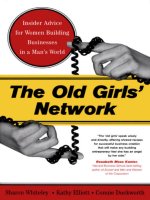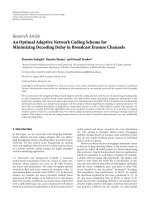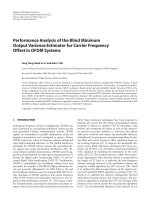THE OLD GIRLS'''' NETWORK: Insider Advice for Women Building Businesses in a Man''''s World doc
Bạn đang xem bản rút gọn của tài liệu. Xem và tải ngay bản đầy đủ của tài liệu tại đây (10.17 MB, 255 trang )
THE
OLD GIRLS'
NETWORK
This page intentionally left blank
THE
A
Member
of the
Perseus
Books
Group
New
York
NETWORK
Insider
Advice
for
Women
Building
Businesses
in a
Man's
World
Sharon Whiteley
Kathy Elliott
Connie Duckworth
OLD
GIRLS'
Many
of the
designations used
by
manufacturers
and
sellers
to
distinguish their
products
are
claimed
as
trademarks. Where those designations appear
in
this
book
and
Basic
Books
was
aware
of a
trademark claim, those designations have
been
printed with initial capital letters.
Copyright
2003
© by
Sharon Whiteley, Kathy Elliott,
and
Connie Duckworth
All
rights reserved.
No
part
of
this publication
may be
reproduced, stored
in a
retrieval system,
or
transmitted,
in any
form
or by any
means,
electronic,
mechanical, photocopying, recording,
or
otherwise, without
the
prior written
permission
of the
Publisher.
Printed
in the
United States
of
America.
Library
of
Congress Cataloging-in-Publication Data
The old
girls' network
:
insider advice
for
women building businesses
in a
man's
world
/
Sharon Whiteley
. . . [et
al.].
p. cm.
ISBN
0-7382-0806-X
1.
Women-owned business enterprises.
2.
Businesswomen.
I.
Whiteley,
Sharon.
HD2341.O426
2003
658.4'21'082—dc21
2003011635
Basic
Books
is a
member
of the
Perseus Books Group
Text design
by
Brent Wilcox
Set
in
11-point
Sabon
Visit
us on the
World Wide
Web at
Basic
books
are
available
at
special discounts
for
bulk purchases
in the
U.S.
by
corporations,
institutions,
and
other
organizations.
For
more
information, please
contact
the
Special Markets Department
at the
Perseus Books Group,
11
Cambridge Center,
Cambridge,
MA
02142,
or
call (617)
252-5298.
To
our
families
and
dear
friends
whose love
and
unconditional support
helps
fuel
our
passions
in
life:
to
Richard
for
your unconditional love
and
support,
to
Sheila
my
mirror
and
Terry
and
Henry
for my
life.
—SHARON
to
Ann,
my
mother
Peg, Margaret,
Mary
and
Bob.
—KATHY
to my
girls, Elizabeth
and
Caroline,
and my
boys,
Andrew, William,
and
Tom.
—CONNIE
This page intentionally left blank
CONTENTS
1 A
Business
of
One's
Own
Setting
the
Stage
1
2
Passion
Turning What
You
Love
Into
a
Real Business
9
3
Vision
Bringing Your Idea Into
the
World
21
4
Pioneering Spirit
Discovering
New
Frontiers
43
5
Tenacity
Passion's Bulldog
59
6
Raising Capital
Translating Your Vision
Into
Dollars
and
Sense
79
7
Focus, Feedback,
and
Flexibility
Jill
Be
Nimble,
Jill
Be
Quick
113
8
Leadership
Lessons
People
Build Companies
133
vii
viii
CONTENTS
9
Life After
the
Survival Stage
Managing
Onward
151
Acknowledgments
171
Tool
Kit 173
Resource Guide
231
Meet
the
Entrepreneurs
233
Index
239
A
Business
of
One's
Own
SETTING
THE
STAGE
A
ship
in
port
is
safe,
but
that
is not
what
ships
are
built
for. Sail
out to sea and do new
things.
Admiral
Grace
Hooper
I
t was
called
the
"Breakfast
for
Champions,"
the
annual
fundraiser
to
benefit
the
Commonwealth Institute,
a
non-profit
organization that helps women develop entrepreneurial
skills
and
expertise.
On
this particular June morning
in
2001, more than
1,000 women gathered
in the
grand ballroom
of
Boston's Fairmont
Copley
Hotel
to
network
and to
honor women entrepreneurs.
Virtually
the
entire
"who's
who"
of the
women's business
community
was
there,
as
well
as
investors, lawyers,
and
others
who
work with
and
support women-led businesses.
And
there
was a
contingent
of
aspiring entrepreneurs, eager
to
make
new
contacts
and
expand their networks
or to
meet potential
in-
vestors
for
their
enterprises.
As the
program ended, people
left
their
tables
and
collected
in
loose, swirling groups: greeting
old
friends,
making
new
ones.
We
were
just
getting
up
from
our
table. Individually,
we
each
have
successful
track records
as top
executives working
in fi-
1
2 THE OLD
GIRLS'
NETWORK
nance, consumer marketing,
and
manufacturing. Collectively,
we
call ourselves 8Wings Enterprises, angel investors with
a
sim-
ple
mission:
to
connect
women with
the
resources they need
to
start
and
build sustainable, high-growth businesses.
Although hailing
from
different
arenas,
we
nonetheless
shared
a
strikingly similar perspective
on the
issues women
face
in
building businesses.
We
were drawn together
by our
common
desire
to
help clear
the
path
for
women
in the
entrepreneurial
world.
We
were receptive
to the
young would-be entrepreneurs
who
approached
us,
their eyes gleaming with passion
for
their
business ideas.
So
when Kate came over
to
pitch
her
idea,
we
gave
her our
full
attention.
Kate
had her
"elevator
pitch,"
the
thirty-second synopsis
of
her
business idea, down pat.
Her
voice rose
for the
finale
that
she
was
sure would
wow us:
"And
we
have
no
competition."
We
could tell
from
the
look
on
Kate's
face
that
she
believed
she'd clinched
our
interest with this last triumphant note,
but
actually
the
four
of us
were thinking, "Uh-oh, another 'babe-in-
the-woods,'
one
more newly minted entrepreneur
who
thinks
she
has no
competition."
Kate
had
made
a
common mistake
be-
cause
she had
never started
a
business before.
She
lacked
the ex-
perience
and the
"know-how"
to go
about
it as
well
as
knowl-
edge
of the
ground rules
for
speaking with investors.
Because
we had
often
discussed
the
knowledge
gap
that
women
face
when starting their
own
businesses, Kate's wrong
turn
led us to a
spontaneously combustible idea.
Sharon watched
as
Kate disappeared into
the
crowd:
"That's
it.
We're writing
a
book."
We
speak from experience. Every year,
in our
role
as in-
vestors, advisors, board members,
and
operators,
we see
hun-
dreds
of
bright-eyed entrepreneurs pitch business plans
to
angel
A
Business
of
One's
Own 3
investors
and
venture capitalists, potential benefactors sitting
at
the big
table behind
their
mountain
of
gold.
And
every year
that
gold
is
parceled
out to the
fortunate few.
Here's something
that
may
surprise you:
On
average,
95
percent
of
all
investor financing goes
to
men.
Why
is it
that
more
men get the
financial backing
to
open
offices,
stock warehouses,
and go
public, while most women
max out
their credit cards, borrow
from
friends
and
family,
and
pretty much
go it
alone?
No one has
ever seriously sug-
gested
that
there's
a
qualitative difference between male
and
female
ideas.
We can
state absolutely that
the
marketplace
doesn't care
who
wore pink booties
and who
wore blue.
The
marketplace
cares only about supply
and
demand,
goods
and
services.
Is
testosterone
a
better business tool than estrogen?
Is it
true
that women can't take
the
heat
and
should stay
in the
kitchen?
The
sound
you
hear
is 6
million businesswomen laughing.
Or, as
a
pioneering venture capitalist once said
as she
took
the
podium
to
receive
an
industry award, "Does this microphone work
for
women, too?"
FACT:
Women's businesses today generate more than
half
the
private
sector
output
of our
gross domestic
product.
FACT:
Women-owned businesses employ more people than
the
Fortune
500
companies combined.
FACT:
Women
who
start businesses have
the
same motivation
as
men: self-actualization, personal achievement,
and
autonomy.
So
why is
there
a
need
for a
book
by
women
for
women?
Because
there
is a
double standard. Because
we are
still
la-
boring
under marketplace inequality. Because
of our
cultural,
societal upbringing,
we
still
don't
feel
entitled
to
succeed,
to
compete
and
win. Because
we
don't
have equal access
to
capital.
4 THE OLD
GIRLS'
NETWORK
Because
we
thrive when someone
offers
us
guidance
that
helps
us
move
our
businesses forward, instead
of
dismissing
us,
stop-
ping
us in our
tracks.
Because there
is a
misconception
that
women
don't
have
the
characteristics needed
to run an
enter-
prise—the
passion,
the
vision,
the
inherent skill set.
We've written
The Old
Girls'
Network
because
we
know
what it's like
to
hand-feed
a
tender young business twenty-four
hours
a
day. We've been there. We're there now: piloting com-
panies, coaching other businesswomen, investing
in
women's
businesses.
The
entrepreneurs
we
profile
in the
book
are
women
we
know,
and
many
of
them
we
have helped directly
by
coaching, advising, and, sometimes, investing directly
in
their
businesses.
We
believe
that
the
road
to
equality
in
every
field
springs
from
the
practical reality
of
economic independence.
We
would
argue that collectively women
are far
less powerful than men,
a
situation that stems
in
part
from
how we
deal with money,
how
we
earn money,
and how we
think about money.
We see the
dis-
parity
in all
aspects
of
life,
but
especially
in
business.
This inequity
is one of the
reasons
we
encourage those
who
yearn
to
create their
own
businesses
but
have
no
role models.
We
are
passionate about helping other women
use
business
as a
vehicle
to
achieve self-actualization
and
economic indepen-
dence.
We are
committed
to
indomitable dreamers,
to
women
like
you.
When asked whether they have
a
dream, most women say,
"No,
I'm
lucky
if I can
make
it
through
the
day,
let
alone have
a
dream."
But we do
indeed have dreams. Dreams
of
starting
businesses—a bookstore,
a
marketing agency,
the
next eBay.
We
dream
of
launching
a
computer software company
or of
devel-
oping
a
better
way to
store X-ray images.
A
Business
of
One's
Own 5
Not
many
of us
were
told,
let
alone encouraged,
that
we
could
express ourselves through
the
medium
of
business.
We
were
not
told that
by
creating
and
selling products
and
services
we
could
manifest
our
ingenuity,
our
intelligence,
our
independence; that
we
could
do
good
for
others
and
have
a
fully
realized
life.
Women's dreams
are
often
about
the
kind
of
person
we
want
to be or the
kind
of
impact
we
want
to
have
on the
world. It's
important
for us to
realize that business
is a
diverse
and
power-
ful
vehicle
for
achieving these dreams.
All
four
of us
have
had
profound
and
enriching experiences
in
the
business world. None
of us had
ever
dreamed
of
becoming
a
CEO; rather,
we
wanted
to
realize
a
vision
of who and
what
we
wanted
to be, and
business became
our
vehicle
to
that realization.
Along
the
way,
we saw how
hard
it was for
women
to
con-
vert
their entrepreneurial spirit into
the
reality
of a
business.
We
saw
that when women succeed, they attribute their success
to
luck.
Yet
when they fail, they place
the
blame squarely
on
themselves.
We saw
that women were lacking mentors
and
role
models,
a
deficit
that
was a
serious shortfall because encour-
agement
pries women
out of
that
fetal
tuck
and
nudges them
into tomorrow's challenges.
We
found that
the
lack
of
financial
backing
put
good ideas
and
smart women
out of
business
be-
fore
they
ever
really started—and that
a
healthy
infusion
of
cash
can
propel
a
burgeoning company over
the
shifting
ground
of
today's
financial
times.
We
also
saw
that women have traits that help
us
succeed;
our
ability
to
network
is
probably hardwired into
our
DNA,
as are
empathy
and
intuition, interpersonal qualities that lubricate
the
business
of
business.
In the
course
of our
combined years
in
commercial pursuits, we've recognized
that
the
characteristics
critical
for
business success
are
truly gender-neutral. Those
who
6 THE OLD
GIRLS'
NETWORK
succeed
figure
out how to
connect their passion
to a
business
idea; they have ironclad determination, what
we
call "positive
perseverance." They
are
flexible
enough
to
accept criticism,
re-
think, reverse, re-create,
and
start again. They have people
skills;
they
can
work with others
and
they
can
inspire
and
lead
a
team.
And
successful
business people
are not
only smart; they
are
tuned
in to
what's
hot and
what's not, alert
to the
vagaries
of the
marketplace
so
that
they
can
hone
the
point
of a
fundamentally
sound business idea.
So
why the
title,
The Old
Girls'
Network:
Insider Advice
for
Women Building Businesses
in a
Man's World?
We
were
famil-
iar
with
the the Old
Boys' Network—the invisible club
that
helps
men to
advance
in the
business world
by way of
their con-
nections.
What
first
came
to
mind
was a fun
play
on
words
and
a
way of
illustrating
a
counterpoint
to
that
well-understood
and
sometimes envied
Old
Boys' Network. Then
we
began
to
reflect
on the
immutable
connection
between women
and
networks
throughout history.
And we
knew
we
were
on to
something.
For
women, networks
are and
always have been about build-
ing
relationships.
We are
pros
at it.
Women's ability
to
forge
communities
and
make connections
is
ancient
it is
tribal,
it is
wired
into
our
DNA.
It is one of the
greatest strengths
we
have
and one of our
most
critical assets
as
aspiring entrepreneurs.
While Sharon's declaration
was
still hanging
in the
air,
we en-
visioned
a
code
book,
a
field
guide
to
help brave, smart, for-
ward-thinking women like Kate shorten
and
enhance their chal-
lenging
journey toward entrepreneurship.
We
thought that
if we
A
Business
of
One's
Own 7
could
map the
terrain, these women would have
a
straighter
shot
at
success.
And
that would
benefit
us
all.
During
the
next eighteen months,
we put
down
our
thoughts
about
the
traits
and
skills
that turn
a
business dreamer into
a
seasoned entrepreneur.
We
asked
a
myriad
of
successful
busi-
nesswomen
to
share their personal stories about
the
roller
coaster ride
of
good times,
as
well
as the
near disasters that
characterized their paths
to the
top.
That
we
often
learn
the
most
from
our
mistakes
may be a
cliche,
but
it's true.
We
think
you'll
find
the
accounts
of
these women enlightening, inspira-
tional,
and
instructive.
So
know that with this book
you
have
tapped into
a
deep
and
valued wisdom base,
not
just
that
of
8Wings,
but of all the
successful
entrepreneurs
who
make these
chapters
come alive, women
who
wanted
to add
their voices
to
ours.
As
we
talked
to
these women about their experiences,
we
were again struck
by how
important relationship building
is to
the
whole process
of
starting,
funding,
and
growing
a
company.
And
the
value
of
relationships
is a
thread that runs through
every
entrepreneur's story
in
this book.
From these stories,
the
book's framework
fell
into place.
Chapters
2
through
5
discuss
the key
traits
all
entrepreneurs
share—essential
must-have qualities without which your busi-
ness
will never
get off the
ground. There
is
passion,
the
energy
source necessary
to
push your entrepreneurial dream
out of the
starting blocks. There
is
vision, which means
not
only seeing
the
big
picture
but
also communicating
it to
enlist
the
support
of
others.
A
pioneering spirit embodies intellectual curiosity
and a
drive
to
succeed
that
sets successful
entrepreneurs,
and all vi-
sionaries, apart
from
the
also-rans.
And an
often-overlooked
8 THE OLD
GIRLS'
NETWORK
quality
is
tenacity,
the
intangible
"vapor"
you
thrive
on
when
your
emotional
fuel
tank runs dry.
Chapters
6 and 7
deal with
the
more concrete aspects
of en-
trepreneurship:
how to
raise capital
to
start
and
grow your
busi-
ness,
and how to
stay
focused
while adapting your business
model
to
changing environments.
The
last
two
chapters,
8 and 9,
bring
it all
together
by
discussing leadership
and
exploring
the
challenges
and
opportunities
you
face
as
your business grows.
Within each chapter you'll
find
expanded definitions
of the
important concepts introduced; these
are
titled "Digging
Deeper."
At the end of
every
chapter you'll
find a
recap
of key
points under
the
heading
"What
You
Need
to
Know."
The
back
of
the
book contains
a
"Tool Kit" containing templates, sample
documents,
and
other
useful
information designed
to
help
you
apply
and
tailor
the
book's concepts
to
your unique business sit-
uation. We've compiled
a
list
of
resources, too, including busi-
ness
organizations
and Web
sites that
can
help
you on
your way.
Our
hope
is
that this book will illuminate
the
unnecessarily
ar-
cane path
to
starting
and
growing
a
business.
Even
with
the
right skills
and
tools, it's essential
to
have
a
mentor
to
provide
feedback
and
encouragement
as you go
for-
ward.
If you
can't
find
such
a
person,
or
until such time
as you
do, we
hope this book will serve
as a
virtual mentor.
We
hope
you'll think
of us as
part
of
your network—your personal coach
and
cheering section,
and for
those times when it's necessary,
your personal
butt
kicker—and that you'll
feel
our
support
as
you
launch your entrepreneurial dream.
We
want
you to
enjoy
the
business
of
becoming
an
entrepre-
neur.
And we
want
you to win at it,
too. Remember,
you are not
alone.
We
wrote this
book
for
you.
Passion
TURNING WHAT
YOU
LOVE
INTO
A
REAL BUSINESS
The
future belongs
to
those
who
believe
in the
beauty
of
their dreams.
Eleanor
Roosevelt
T
he
starting point behind
every
business idea
is
passion.
For
the
entrepreneur, passion
is the
urge
or
compulsion
to ex-
press your creativity
by
bringing something
new
into
the
world—
something
that
you
have daydreamed about
for
many years,
something—a
hobby
or a
vocation—that excites
and
energizes
you
to the
core.
You
can't
learn
it. You
can't
buy it. You
know
it
when
you
have
it.
We
believe that
if you
have
a
recurring daydream about building
a
business
out of
something
you
truly love,
go for it.
Cheryl
Straughter
did
just
that.
The
last time
we saw
Cheryl, restauran-
teur
and
entrepreneur,
she was
making
a
presentation
to a
large
group
of
business executives, aspiring entrepreneurs,
and the
9
10 THE OLD
GIRLS'
NETWORK
press. From
the
moment
she
took
the
stage, Cheryl
was
like
a
sparkler
on the
Fourth
of
July.
And
when
she
told
her
story,
she
just
about burned
the
place down.
Her
energy
was all the
more
amazing
to us
when later
we
found
out
that she'd been
up
until
4:30
that
morning prepping
to
cater
a
luncheon
for five
hundred
people
that
very
day.
Cheryl's story
is an
example
of
passion writ large. From
the
time
she was a
teenager,
she had
dreamed
of
owning
her own
restaurant—her
own
place.
"In the
traditional black
family,
a
lot of
activity centers around food
and the
kitchen.
As we
were
growing
up, we
would gather
in the
kitchen because
that's
where
my
mother
and
grandmother were cooking."
And
this
was
where
the
seeds
of her
passion
for
starting
a
restaurant were
sown; this
was
where
she
found
the
desire
to
create
a
sense
of
community around
good
home
cooking,
not a
burger joint
or a
high-end
place. Rather,
she
wanted
to
create
a
neighborhood
restaurant
that welcomed
its
patrons
as
family
and was
afford-
able
for the
average person
to
visit every day.
A
single mother raising
her
young son, Keith, Cheryl didn't
have
resources
to
call upon—no house
to
mortgage,
no
collateral
of
any
sort.
She
soon discovered that passion
was her
biggest
asset: "The part
of my
presentation that really caught people's
eyes
was my
desire,
my
drive,
and my
burning motivation."
As
Cheryl illustrates, passion
fuels
every business idea.
The
hallmarks
of
passion
are
total
absorption,
round-the-clock
en-
gagement,
unfiltered
imagination, unbridled possibility,
and in-
tense
motivation. Passion
flows
from
your core.
It is
your inner
flame.
What does passion have
to do
with building
a
business?
EVERYTHING!
Entrepreneurs
can be
passionate
about anything. They
can be
passionate about galvanized garbage cans, about diesel truck
Passion
11
parts, about silk scarves, even about insurance policies.
The key
is
to
find
what
makes your
heart
sing. Passion
is the
energy
source driving
you to
create
and
build your enterprise with
an
unrelenting focus
on
your dream.
It is the
required
emotional
asset that never shows
up on
your balance sheet. Jaimee Wolf
lives
this
point
fully.
Even
as a
young girl, Jaimee knew
she was
destined
to be-
come
an
entrepreneur; while
her
friends
engaged
in
other
ac-
tivities, Jaimee always played
"owner
of
something."
She had
her
share
of
lemonade stands
and was
always conjuring
up
new
business ideas—such
as the one
where
she
"borrowed"
newspapers from
the
corner
bin and
sold them herself. Until,
that
is, her mom
gave
her a
fast
course
in
business
ethics.
After
graduating from college
and
becoming involved
in
sev-
eral
marginally
successful
businesses, Jaimee found
her way
back
to the one
thing that
had
consumed
her as a
kid: video
games.
Jaimee's interest
was first
sparked
in
grade school with Pong,
one of the
original video game releases.
By
high school,
she had
developed
a
full-blown passion.
She
perfected
her
gaming skills
while
laid
low for a
month with mononucleosis
and
then
be-
came
a
fanatic. After
a
brief foray
into
the
record
industry after
college, Jaimee found herself
in the
computer software
field; but
she
still spent
her
free
time playing video games. Finally,
she got
it
what
she had
learned about producing records
and
com-
puter software could
be
applied
to
licensing
and
producing
video
games. There, right
before
her
nimble
fingers, was her fu-
ture. Jaimee
had
made
the
connection between
her
life-long
pas-
sion
and a
profitable business opportunity.
Today,
her
successful
global company, Xicat, which publishes
video
games,
is
considering filing
with
the SEC for a
public
12 THE OLD
GIRLS'
NETWORK
stock
offering.
With titles such
as
X-Plane, ChargeNBlast,
and
Iron Aces, it's this gaming girl's dream come true.
Marcia Weider believes that most passions
can be
turned into
a
business,
and she has
done
just
that.
Now a
motivational
speaker
and the
author
of
Making Your Dreams Come True,
Marcia
has
taken
the
concept
of
helping others
to find
their pas-
sion
and
follow their dreams
and has
built
it
into
a
thriving
business,
Marcia Weider Enterprises.
Her
clients include corpo-
rations
and
organizations
all
over
the
world
from
the Gap to the
Girls
Scouts.
But it
wasn't always
so.
Early
in her
career,
Marcia
had
built
a
multimillion-dollar
marketing
and
media company. Then,
just
when
the
business
was
running smoothly, suddenly
she
lost everything. Unbe-
knownst
to
Marcia,
her
bookkeeper,
out of
negligence
and not
intent,
had
failed
to
withhold payroll taxes
and did not
make
the
required payments
to the
IRS. When
the
error
was
discov-
ered,
the
late interest charges
and
significant
penalty payments
that
had
accumulated forced Marcia
to use her
company's prof-
its
and
take
a
second mortgage
on her
house
to
satisfy
these
obligations.
Still
it was not
enough.
"I
worked
my
tail
off to pay
this
debt,
but it
wiped
me out financially. I had
been president
of
the
National Association
of
Women
Business
Owners, driving
around Washington, D.C.,
in a
Jaguar, lunches
at the
press club,
lah-de-dah,
and
that whole identity collapsed."
After
a
year-
long self-described
"lost"
period
and
still
in
transition,
Marcia
moved
to San
Francisco, rented
a
small apartment,
and
began
the
process
of
starting over.
"I
went
from
being clear, inten-
tional,
and
results-oriented
to not
knowing.
And
there
was
something about being
in the
'not knowing' that invited
a
deeper exploration.
The
promise
I
made
to
myself
was
that
I
wouldn't
go
start another business
just
to be
successful.
I
knew
Passion
13
how to do
that,
but it
didn't really
feel
like that's where
my
growth was.
I
wondered what
my
deeper calling
in
life
would
be.
This
led me to
talking
to
people about purpose
and
about
their passions, which then
led me to
this
new
work
that
I
do."
Marcia's
passion
for
starting
her new
business
was
ignited
while
she was
volunteering
at the
Make-A-Wish Foundation,
a
group that grants wishes
to
critically
and
terminally
ill
children.
"I was so
moved
by who
they were
and
what they were about
that
I
decided that
I
wanted
to
make
my
life
about
how
people
can
realize their dreams.
For me, it
wasn't
just about sick chil-
dren,
it was
about sick companies—organizations where people
had
lost their vision, lost their passion,
and
weren't aligned
around anything.
I
think purpose often
has to do
with mission
. . .
it's
all
tied together—purpose, mission,
and the
passion
for
what you're doing
and for who
you're being."
Maxine Clark,
CEO of
Build-A-Bear
Workshops, couldn't
agree
more.
We
traveled
in her
wake
as she
arrived
at the
Para-
mus
Mall
in New
Jersey
to
open
a new
Build-A-Bear
Workshop,
her
eightieth
in five
years. Maxine,
a
blur
of
action
in her
Build-
A-Bear
uniform
of
khakis, denim shirt,
and red
sweater vest
with company
logo,
snipped
the red
ribbon
and
hoards
of
shop-
pers streamed
in.
Maxine
had
trouble describing
the
delight
she
felt
then: "When
I
smile, it's such
a
different
feeling.
I
can't even
explain
it I
wish
I
could articulate
it.
I've created
an
envi-
ronment where
I can be me and
where others
can be who
they
are—a warm
and
fuzzy
environment, literally
and figuratively."
Maxine began
her
journey
to
Chief Executive
Bear
when
she
was
growing
up in
Florida.
She
told
us
that "shopping
was en-
tertainment, engaging
and
magical."
As a
young girl
in the
1950s,
she
would dress
up and
take
the bus
with
her
mother
to
go
window-shopping
in
downtown Miami.
"We
couldn't neces-
14 THE OLD
GIRLS'
NETWORK
sarily
afford
what
we saw in the
windows,
but
that
didn't
make
it any
less
fun to go and see and
wish.
It was
pure
fantasy
with
fashion
shows, lunch with kiddie cocktails
in the
tearoom,
and
white
gloves.
We
especially loved shoes.
My
mother could stitch
up
clothes much like
the
store versions
and
with
the
money
we
saved,
we
could
buy the
right shoes
and
take them home
that
day."
After
college, Maxine headed straight
for May
Department
Stores
to
indulge
her
passion
for
creative retailing;
she
worked
hard
to
learn every aspect
of the
business. Twenty-five years
later
to the
day, Maxine became
the
president
of a May
sub-
sidiary, Pay-Less Shoe Stores.
"I
loved
my
job. Pay-Less
was the
May
Company's largest division,
a
$2.5-billion,
4,500-store
chain.
But a day
came when
I
noticed
that
shopping
as a
form
of
entertainment
had
disappeared,
and on a
personal level,
my
own
enthusiasm
for
shopping
had
crashed. Work, too,
was
los-
ing
its
buzz.
My
psychic income bank account
was at
zero
be-
cause
I
wasn't
loving
my
work
any
more.
I saw
that
too
much
of
my
creativity
and
talent
was
being lost
to
meetings
and
paper-
work.
I
wasn't
having fun."
Maxine toyed with ideas about what
to do
next,
about
how
to
turn
the
clock back
and
re-create
the
excitement
of
shopping
she
had
felt
as a
child.
In
1996, while touring
a
stuffed-animal
factory,
the
Build-A-Bear
concept
hit
her. "The idea
for
Build-A-
Bear
Workshops
was
really
very much
an
extension
of
what
I'd
done
my
entire
life.
When
I
envisioned
the
idea,
I
crossed
from
corporate businessperson
to
entrepreneur."
She
also knew
first-
hand
the
power teddy bears have over children. When Maxine
was
ten,
her
father
took
her
well-worn "Teddy" away because
he
thought
it
would solve
her
thumb-sucking problem.
"It
didn't,
and
I've been looking
for him
ever
since."
Passion
15
In
just
five
years,
Maxine
has
accomplished
the
unheard
of in
today's
retail climate—the building
of an
award-winning chain
of
113
stores with sales
of
$170 million,
not to
mention thou-
sands
of
satisfied
customers
and . . .
happy bears.
"I
left
the
cor-
porate world
to
bring theater back into retailing
and to
give
back
to the
industry that
had
been
so
good
to me. . . .
It's
all my
dreams
rolled into one."
So
how
important
is
passion?
We say
it's critical.
For a
long
time
when you're taking your vision forward, passion
is
every-
thing
and you are the
flag
bearer,
the
embodiment
of
your idea.
Your
passion
for
your business will inevitably
go
through cycles
of
"in
love"
and "in the
doldrums,"
but if you
lose your passion
altogether, you'll lose sight
of the finish
line
as
well. This
can
spell
the end of the
race because there's
no one
else
to
say, "Oh,
come
on, you can do
it,"
or
"It's
a
great idea.
The
world needs
you."
That's
the job of
your
passion.
Cheryl's passion
for her
restaurant
concept
drove
her to
visit every bank
in the
city
of
Boston;
after being turned down
by one
after
the
other,
she
forged
ahead
and
uncovered
a
city-sponsored loan program
de-
signed
to
help revitalize
the
inner city.
Viewed
from
the
outside, passion
is
expressed
by
different
people
in
different
ways. Some entrepreneurs make sparks
fly
whenever
they're around.
For
others,
the
feeling
is
private,
but
it
burns inside
like
a
bright blue
flame.
However
it is ex-
pressed, passion
is an
energy source that drives
you to
create
and
build your enterprise with
an
unrelenting focus
on
your
dream.
It
compels
you to
take risks,
to
commit
to
your vision
in
the
face
of
resistance, other people's doubts,
and
your
own
fear
of
failure.
Passion
can't
be
faked. When you're
in
love with your busi-
ness idea,
people
know
it, and
when you're
acting,
they know
16 THE OLD
GIRLS'
NETWORK
that, too. Passion
is
like
a
magnetic
force
that gets other peo-
ple
to
join your cause
without
your even asking. It's
an
energy-
to-energy
connection:
a
subliminal suggestion
that
makes oth-
ers
think, "Wow, this person's going places
and
doing
really
interesting
stuff
and I
want
to
help her."
Bottom line: Passion
is the
required emotional asset that
doesn't
show
up on
your balance sheet,
but can
stop
your busi-
ness
cold
if you
don't
have
it.
Now
that your passion's
ignited
and you
want
to get
started,
you
prob-
ably
don't
know
where
to
begin.
Here's
our
list
of
some
of the
first
things
you
should tackle:
1.
Begin
to
flesh
out
your
business
plan,
starting
with
your vision
for the
business.
The
next chapter
will
assist
you in
this.
2.
Find
that
mentor
who can
help
you
move forward. Start
by
mak-
ing a
list
of the
qualities
such
a
person should have
and
note
who in
your network
could
either
be
your mentor
or
help
you to
find
that person.
3.
Join
a
local
or
regional
business
organization that dedicates itself
to
developing entrepreneurs.
4.
Name your company. Apply
for a
registered trademark
for use in
your
industry. This
will
also
inform
you
whether
the
name
is
available.
If
not,
get
another name.
You can
begin some
of
this
research
on
your
own on the
Internet.
5.
Secure your
Internet
domain
name(s)
in all
venues relevant
to
your
business
(".com"
usually
suffices
for
commercial ventures).
If
possible, secure other names similar
to the one you
will
be
using,
as
well
as
common misspellings.
6. Set up
your personal e-mail
address
under
the
company domain.
(continues)









